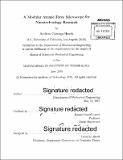A modular atomic force microscope for nanotechnology research
Author(s)
Houck, Andrew Careaga
DownloadFull printable version (12.29Mb)
Other Contributors
Massachusetts Institute of Technology. Department of Mechanical Engineering.
Advisor
Kamal Youcef-Toumi.
Terms of use
Metadata
Show full item recordAbstract
The atomic force microscope (AFM) has become an essential tool in a wide range of fields, from materials science and semiconductor research to molecular biology. Various research efforts have enhanced the capabilities of this powerful instrument, which has enabled new insights into nanoscale phenomena. Despite decades of research, state-of-the-art AFMs are not widely utilized. In order to accelerate the proliferation and development of these instruments, a modular atomic force microscope is presented. The optical, mechanical, and instrumentation components of the AFM can all be easily exchanged. The instrument can be reconfigured for fundamentally different imaging tasks and can be used as a platform for continued research efforts. The optical beam deflection (OBD) setup can be configured for coaxial or off-axis detection for use with cantilevers of any size. A simple and low-cost design is presented, and an AFM is implemented based on the design. The instrument is tested in two different imaging configurations. First, a configuration for high-speed imaging with small cantilevers is used to image copper deposition on gold in contact mode in liquid. Second, a configuration for large cantilevers is used to visualize the mechanical properties of a polymer blend in tapping mode in air. The flexibility of the modular instrument is leveraged to develop a new capability for high-speed AFM. Multi-actuated and dual-actuated sample scanners have enhanced the high-speed performance of AFMs by combining multiple nanopositioners with different range and bandwidth characteristics. While this and other improvements have made AFM scanners effective for high-speed imaging, out-of-plane sensing has not been developed adequately. Out-of-plane sensing enhances the capability for quantitative in situ analysis by measuring changes in sample thickness during dynamic processes. This is especially useful in materials science and electrochemical applications, in which understanding of changes in bulk sample thickness is essential. A sensing methodology for high-speed dual-actuated out-of-plane positioning is presented. A silicon-type strain gauge is used to measure the displacement of the low frequency nanopositioner. A piezoelectric sensor is used to measure high-frequency displacement. The sensor is incorporated into a novel diaphragm flexure nanopositioner with annular piezoelectric actuator. Fusion of the two sensors for high-speed imaging tasks is discussed. Performance of the two sensors is evaluated, and further developments to integrate the sensing methodology into the modular atomic force microscope are discussed. Finally, the modular AFM is used in two dynamic nanoscale imaging tasks. High speed atomic force microscopy has enabled many novel discoveries across a range of applications, especially in biological fields. However, applications in materials science and electrochemistry have not been as thoroughly explored. First, electrochemical deposition of copper on gold during cyclic voltammetry (CV) trials is studied. Electrochemical data from a potentiostat during the CV trials collected in parallel with the AFM images to enrich the analysis. The effect of different initial surface conditions on deposition and stripping is observed. Second, calcite dissolution in low-pH environments is imaged. Dissolution processes in sulfuric and hydrochloric acid solutions are compared. It is apparent that the rhombohedral crystalline structure of the calcite clearly influences the dissolution kinetics in both cases. Erosion of thick calcite terraces is observed in both solutions. However, differences in the dissolution kinetics suggest that the anions play an important role in the process. Multi-actuated sample scanners are particularly well-suited for these two applications, as they involve rapid changes in features at the nanometer scale (e.g. calcite monolayer etch pits and copper nucleation sites) as well as the micron scale (e.g. calcite terraces and copper grains).
Description
Thesis: S.M., Massachusetts Institute of Technology, Department of Mechanical Engineering, 2015. Cataloged from PDF version of thesis. Includes bibliographical references (pages 91-97).
Date issued
2015Department
Massachusetts Institute of Technology. Department of Mechanical EngineeringPublisher
Massachusetts Institute of Technology
Keywords
Mechanical Engineering.